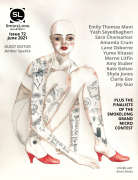Presenting round characters in flash is tough. One trick is to use a trademark gesture/activity. How did you find your narrator’s wildly effective “signature move?”
I’ve always loved that Flannery O’Connor quote about descending “to the concrete where fiction operates.”[1] It’s something I’ve had to practice at, but (surprise, surprise!) it works. Also, this particular story started with one of Monet Patrice Thomas’s marvelous writing challenges. One of her constraints is always that entries must include a literary rendering of sex. So I was on the lookout for ways the narrator might connect physically with other characters. What ultimately surprised me was that she connected with Agnes, and it was not a sexual connection.
The narrator focuses on Agnes, but first-person stories are always about the “I.” How did you ensure that a reader would be able to “peek around” your “I?”
That’s a great question. In a way, the question is sort of what the story is asking: To what extent can anyone ever ensure what anyone else sees? Probably close to zero. But we can make guesses, I think. And we can try to correct our own assumptions. And we can ask each other to describe what is seen.
An optometrist’s office dovetails nicely with your questions about perception/self-perception. Which came first—setting or theme?
One hundred percent: the setting. As I mentioned, this story started in response to one of Monet’s challenge prompts, specifically that the literary portrayal of sex take place outside of a bed. And further, the word bed couldn’t appear anywhere in the piece. A clothing store felt cliché because you’ve got the dressing rooms. A nightclub also felt cliché. Gym? Cliché. Hospital? Too many beds. Once I imagined the optometrist’s office, the story took off. The funny thing is that none of the drafts ever included sex. So I would have failed that challenge.
[1] From Mystery and Manners: Occasional Prose



 The core workshop of SmokeLong Fitness is all in writing, so you can take part from anywhere at anytime. We are excited about creating a supportive, consistent and structured environment for flash writers to work on their craft in a community. We are thrilled and proud to say that our workshop participants have won, placed, or been listed in every major flash competition. Community works.
The core workshop of SmokeLong Fitness is all in writing, so you can take part from anywhere at anytime. We are excited about creating a supportive, consistent and structured environment for flash writers to work on their craft in a community. We are thrilled and proud to say that our workshop participants have won, placed, or been listed in every major flash competition. Community works.